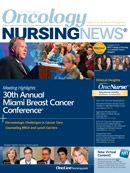Anticipatory and Delayed Nausea Remain Concerns for Patients on Chemotherapy
Despite progress in treating chemotherapy-induced nausea and vomiting, especially in the acute phase up to 24 hours after treatment, the condition is still one of the side effects patients fear most.
Hope Rugo, MD
Despite progress in treating chemotherapy-induced nausea and vomiting (CINV), especially in the acute phase up to 24 hours after treatment, the condition is still one of the side effects patients fear most, according to Hope S. Rugo, MD, professor of Medicine and director of Breast Oncology and Clinical Trials Evaluation at the Helen Diller Family Comprehensive Cancer Center, based at the University of California, San Francisco.
“Patients feel like this is a really big deal,†said Rugo, during one of her sessions at the recent Miami Breast Cancer Conference®. “We’ve done a remarkable job of controlling vomiting in most patients,†she said—once the most feared complication of chemotherapy— “but we’re still not so great on nausea.â€
Rugo also highlighted progress in controlling acute CINV, whereas delayed CINV (occurring 24 hours to up to 6 days after chemotherapy) remains problematic. “Most of our patients receiving AC [doxorubicin and cyclophosphamide]– type regimens have some degree of delayed nausea. We see it a lot with the platinum salts as well, and you can see it with a host of other agents.â€
Currently, the most effective drugs for the prevention and treatment of CINV, Rugo said, are the serotonin/5-HT3 receptor antagonists, the new substance P/neurokinin-1 (NK-1) receptor antagonists, and steroids (Box). “Interestingly, steroids are one of the very important agents that play a critical role in preventing and treating CINV.â€
National Comprehensive Cancer Network (NCCN) Guidelines offer guidance for emesis prevention for patients receiving agents which place them at high, moderate, or low risk for CINV. Rugo, who is a member of the NCCN Panel on the Prevention of Nausea and Vomiting, noted that recent changes to the guidelines indicate palonosetron as preferred, primarily for patients at high risk for emesis, but also for those at moderate risk, because of the drug’s combination of acute and delayed effects.
Three Major Classes of Antiemetic Drugs
Steroids (dexamethasone)
5-HT3 Receptor Antagonists
- 2nd Generation: palonosetron (IV only) Effective for both acute and delayed CINV as a single IV infusion
- 1st Generation: ondansetron, granisetron (also in transdermal form), dolasetron (PO only) Primarily effective for acute CINV, also for rescue
Neurokinin-1 antagonists
- Aprepritant, fosaprepitant Effective for delayed CINV when given with a 5-HT3 receptor antagonist
Rugo said that it’s also important to tell patients about potential toxicities of agents used to control CINV, so they can take preventive measures. “The 5-HT3 receptor antagonists cause headache in a subset of patients and constipation in almost everybody,†she noted, and patients who are at risk for prolonged QT can also be at risk with repeated doses. She added that for the N-1 receptor antagonists, the primary risk is drug–drug interactions, more so with the oral form than IV.
Researchers have looked at how patients’ actual experiences with CINV match up with physicians’ and nurses’ predictions and perceptions. “This is a very sobering lesson for all of us,†said Rugo. “We’re really good at assessing what our patients think in the acute setting,†but when CINV persists for days, “our perception generally underrates it, compared with what patients think.â€
Anticipatory emesis can be a big problem as well, said Rugo. “Good control in the first cycle significantly reduces anticipatory nausea and emesis,†she stressed. “Use your best drugs up front.†In a young woman who is receiving AC chemotherapy, for example, “you want to pull out all the stops; you can always cut back, but adding more is difficult because of this anticipatory emesis.†Additional strategies include relaxation, hypnosis/ guided imagery, music therapy, acupuncture/ acupressure, and alprazolam or lorazepam the night before, and morning of, treatment.
“Better understanding of the mechanisms of action have led us to the development of two very effective new classes of drugs,†Rugo concluded, “and hopefully this will lead to even better agents in the future.â€




